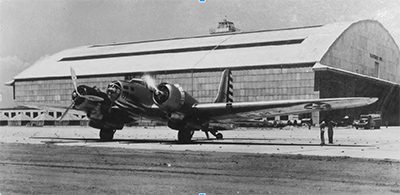 “Wouldn’t it be cool to have a school in a historic hangar?” I asked my friend. We had been driving around Lowry (the site of the former Air Force Base in Colorado) for well over an hour, looking for a suitable site to open a preschool. Five real estate agents had given us the very disappointing news that the market here was saturated and nothing was available. Not prepared to give up and determined to find something in this area, we decided to set out on our own! “Just call,” she said, pulling into the parking lot. I did, and the rest is as they say, history.
“Wouldn’t it be cool to have a school in a historic hangar?” I asked my friend. We had been driving around Lowry (the site of the former Air Force Base in Colorado) for well over an hour, looking for a suitable site to open a preschool. Five real estate agents had given us the very disappointing news that the market here was saturated and nothing was available. Not prepared to give up and determined to find something in this area, we decided to set out on our own! “Just call,” she said, pulling into the parking lot. I did, and the rest is as they say, history.
I believe everything happens for a reason. Reflecting back on my life, I can clearly see the steps that have brought me to this point. Today, as I sit in my office and hear the hum of the children busy at work, my heart fills with joy and gratitude. It has not been an easy journey. In fact, most of it has been very hard as I struggled against odds to keep Montessori in its purest form.
I was introduced to Montessori whilst pregnant with my first child. Since then it has been my philosophy for life, gently guiding me and keeping me anchored through all the storms that I have weathered. We have lived in several parts of the world and in each, I have carried my beliefs, fine tuning my understanding of Montessori and, spreading it only in it’s purest form.
Back in the USA, after a five-year stint in Indonesia where I had been running a Montessori teacher-training center, I opened one in the basement of our home. Within the first year of operation, our center received its non-profit status, accreditation from MACTE and, soon after, Title IV recognition. The students that I trained loved the atmosphere of being in a home, felt very nurtured and often called it “the womb”.
The problems began when they completed the academic portion of their training and went out to do their internship. None of the schools met the standards to which they had been trained and they often returned to me telling me about their frustrations. I always encouraged them to “work it out” and that every experience, no matter how negative, provided one with an opportunity to learn. However, I could see that I was failing them. For their training to be complete they needed to see and work in classrooms that followed the philosophy and methodology as they had been taught.
Eventually, I had to put my foot where my mouth had been all along and decided it was time to open a primary classroom alongside the teacher-training center. It was June and we were still driving around looking for space with the intention of opening the school in August! We received a lucky break when the administration from the Hangar called us back and fixed a time to see the place. They were not very sure if this was going to work for us and asked if we had peeked in through the windows to sort of get an idea of what the space was like. We had not and what lay ahead was a big surprise, to say the least!
We walked into a room that was dark with brick walls and concrete floors. The windows had been taped over and it did not seem that anyone had entered this place for many years. We were informed that Hangar 2 is a historic hangar from the time of the Second World War and where we were now standing were the administrative offices. In 1934, the US Army had sought a new training site for its growing Army Air Corps and chose Denver as the location for the new facility.
Named after 2nd Lt. Francis Lowry, whose plane was shot down during World War 1, Lowry Field was used to train thousands of incoming servicemen during World War II. After the war, Lowry Field became Lowry Air Force Base, and President Dwight D. Eisenhower even chose Lowry as the location of his Summer White House from 1952 to 1955. As a part of the national downsizing of the US armed forces in the early 1990s, Lowry Air Force Base was decommissioned and closed in 1994. Since then the historic Hangar No. 2 has been placed on the National Register of Historic Structures in recognition of its heritage.
Despite the looks of the place, I knew we were standing in history and could not help but feel butterflies in my stomach. I walked across the large room and could see a Primary classroom. The high ceilings were a definite advantage and the room had no obstacles such as a pillar down the center. I hoped the windows would provide enough light once the coverings had been removed. In any case, I had always said it did not matter where it was, I could create a pure Montessori classroom. Well, here was my chance and my challenge.
Little did I know of the challenges that lay ahead… this was a historic building and permits and permissions to redevelop it can have you holding your breath for a very long time. One of the earliest buildings in the country to be constructed with steel trusses, the structure has an interior span of more than three football fields in area. However, the building was unused since the base closure and bringing it up to modern safety standards was not only expensive but also difficult. Added to this was the even bigger challenge of meeting state licensing requirements for opening a center with preschool children.
My heart was set and no obstacle was too big to be overcome. Montessori was my inspiration and nothing had stopped her. I loved the idea of having my school surrounded by history. The landlords worked with me, encouraging me to draw up a plan with a needs and wants list. What more could I possibly ask for? I got to work and in no time at all, I could clearly see the classroom with all the different curriculum areas. It was not hard at all. I had lived and breathed Montessori for the past thirty years and had trained my teacher trainees to think about Montessori as a philosophy for life. I had always said it was not the Pink Tower or the Golden Beads that made a Montessori school. In fact, one should be able to open a Montessori school with none of the materials and only natural resources available. If one is trained correctly, one should be able to do Montessori anywhere!
Impulsively I chose yellow for the walls and a few years down the road realized why I had done so—it was the exact shade of yellow of the original Casa dei Bambini in San Lorenzo. We had to cover the concrete floors and I thought wooden floors would be beautiful. However, the budget had to be reckoned with and on a whim, I went to Lumber Liquidators and asked them if they would consider donating the floor to a school. No one was more surprised than I was when they agreed and all they wanted in return was to make a video on our school.
The playground was a whole different story! I had dreams of an all-natural playground that were obviously not coming to fruition. For all, we had to play with was this solid tarmac from the 1930s. We decided it was best not to try and break it but to work around it and we did the best we could with what we had.
In the end, the children loved it and that’s all that mattered. We used natural timber for a balance beam and stepping-stones and had big planters so we could have some greenery. We had natural musical instruments and even created a labyrinth and Zen garden.
A few months behind schedule, our school opened with four children and a teacher-training center. We were blessed to have David Elkind (author of The Hurried Child; The Power of Play, etc.) cut the ribbon and open the school with the very touching opening remarks:
“One small step for Punum, one great step for childhood.”
Tomorrow’s Child / November 2016 / p 34






